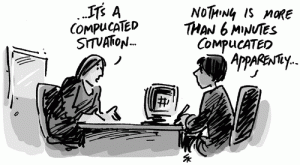2.6 Billing
Gemma Smyth
Billing
The billing process usually consists of the following steps:
- The firm brings on a new client and gathers information about their legal issues.
- The retainer is signed, and billable time and disbursement fees/expenses are logged throughout the case. For larger matters, the client pays a retainer fee. Sometimes, the client does not pay at the outset but rather is billed upon completion of work. Also note that some lawyers are paid on contingency (meaning, they are paid a percentage of any successful settlement reached).
- Periodically (based on a regular billing cycle) or as set out in the retainer, the bills and expenses for each client are entered into a draft bill.
- The bill is then regularly adjusted throughout the matter.
- A final version of the bill is created and sent to clients.
- Clients pay through the accepted payment method, if funds are required. On contingency, the client pays a percentage of their settlement as set out in the initial retainer agreement.
Many placement programs do not involve students in the billing process or allow their work to be billed. Nonetheless, if a firm does bill clients, it is important to understand how that might impact your work.
Clinics and other workplaces sometimes encourage students to docket their time, even if the time is not ultimately charged. Understanding how many hours have been devoted to a file can be helpful for funders or to understand how time is being used on particular types of issues. Getting used to accounting for your time in this way can also be a helpful habit for future employment – including owning one’s own firm.
There are several ways that law firms typically bill.
Lawyers often bill for services by the hour. Rates for lawyer services per hour range widely, typically based on the size of firm and lawyers’ experience. Some clients prefer some sense of how much they can expect to pay for a service, which makes this manner of billing challenging. One way of mitigating this is by giving some sort of Rate Cap, which typically means the lawyer will not exceed a certain total fee. More on the “billable hour” is contained below.
Value-Based Billing or “Flat Rate” Fees
Value-based billing is another revenue method for lawyers. It is typically a more cost-effective form of billing for the clients. This method of pricing legal services engages predictability of costs to clients as well as revenues to firms. Value-based billing is essentially a flat-fee billing structure that forces lawyers to work within a budget. In doing so, firms are more responsible and accountable for how they are distributing resources and charging client accounts. This form of billing promotes can promote transparency for clients. This method is often used for wills, some types of divorces or separation agreements, some real estate transactions and initial consultations.
Fixed Retainer
Some business or other entities might wish to pay some sort of annual or biannual “rate” that allows them legal services for a period of time. This can be a good option for some businesses, but the often unpredictable nature of legal work can also make this less attractive.
Contingency Fee
This is a type of billing in which the lawyer’s remuneration is “contingent” on the outcome of a matter. This often means clients pay little or nothing at the outset of a matter, but receives a percentage of any final award to the client or clients.
The Billable Hour
A billable hour is one hour of time dedicated to a task, file or project that can be charged to a client according to an agreed amount. As a result, non-billable hours are times that are not charged to the client. These hours are usually focused on other aspects of the job such as professional development, client development and strategy that are not involved in the client’s case.
Despite multiple criticisms, the billable hour remains a very popular way of paying for services:
“A survey of in-house lawyers published in the December 2014 edition of Canadian Lawyer magazine reveals that 47% of Canadian corporations cite billable hours as the primary way they pay their bills to outside law firms”.
This is less by 10% than the year before. Despite the drop to a little less than half, the number of firms committed to the billable hour is still very high.
Billable hours has been criticized on multiple fronts. This model can pit client objectives against the financial incentives of billable hours for law firms. It can also lead to lawyer burnout and stress.
Most private firms operate using the “billable hour”, meaning the amount of time spent working on a legal matter that is then charge to a client. Many firms break up a billable hour into 6 minutes increments. In most externship placements, you will not have to bill your time according to this practice. However, understanding how the billable hour model differs from the salaried model more common in a clinic or non-profit context can help explain why and how some clients and communities get left behind. As Justice Pepall wrote,
“. . . there is something inherently troubling about a billing system that pits a lawyer’s financial interest against that of its client and that has built in incentives for inefficiency…“In my view, it is not for the court to tell lawyers and law firms how to bill. That said, in proceedings supervised by the court and particularly where the court is asked to give its imprimatur to the legal fees requested for counsel by its court officer, the court must ensure that the compensation sought is indeed fair and reasonable…” Bank of Nova Scotia v. Diemer, 2014 ONCA 851, (online: https://www.ontariocourts.ca/decisions/2014/2014ONCA0851.htm).

There are many critical perspectives on this practice explored below and in earlier Chapters.

